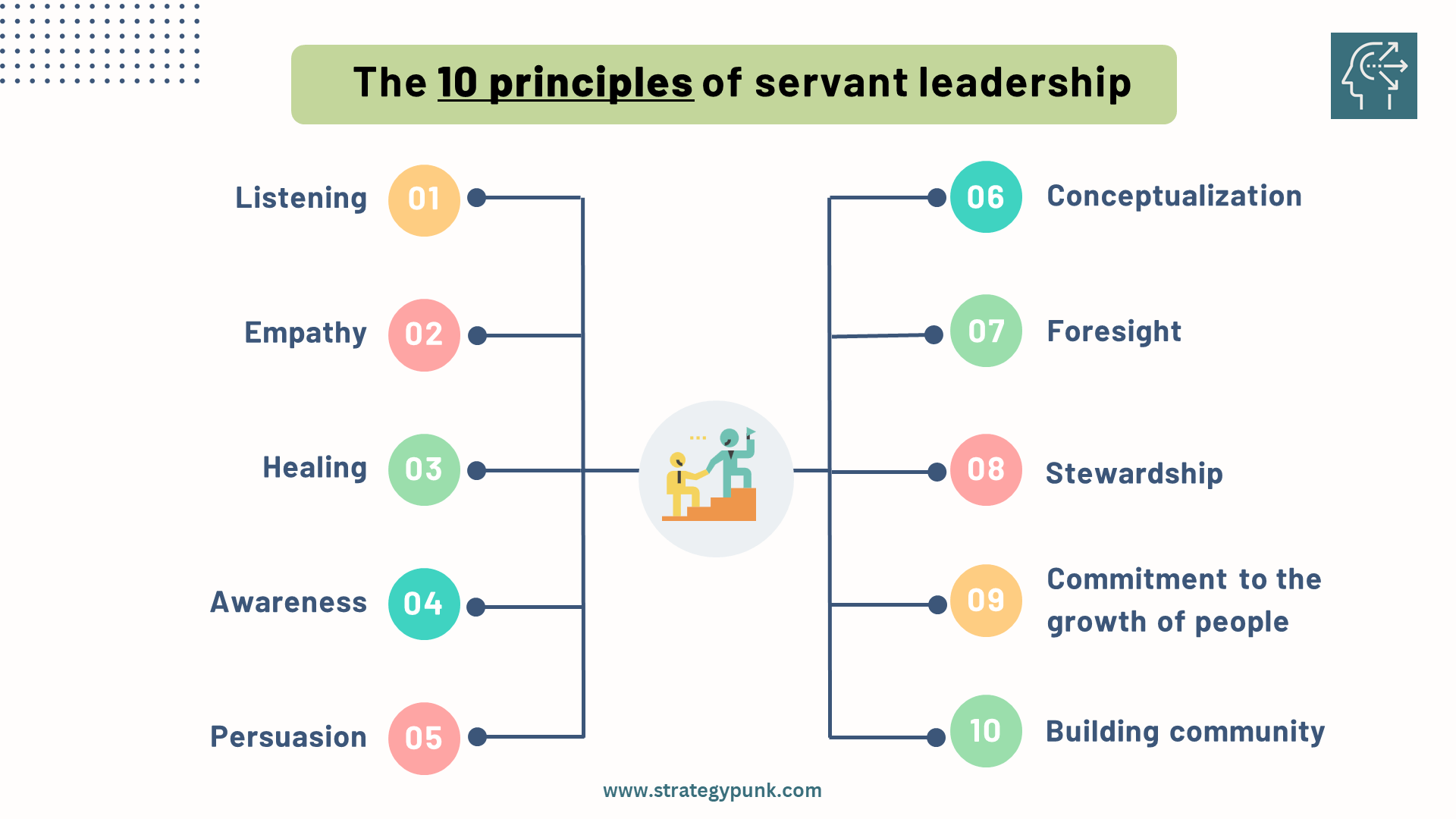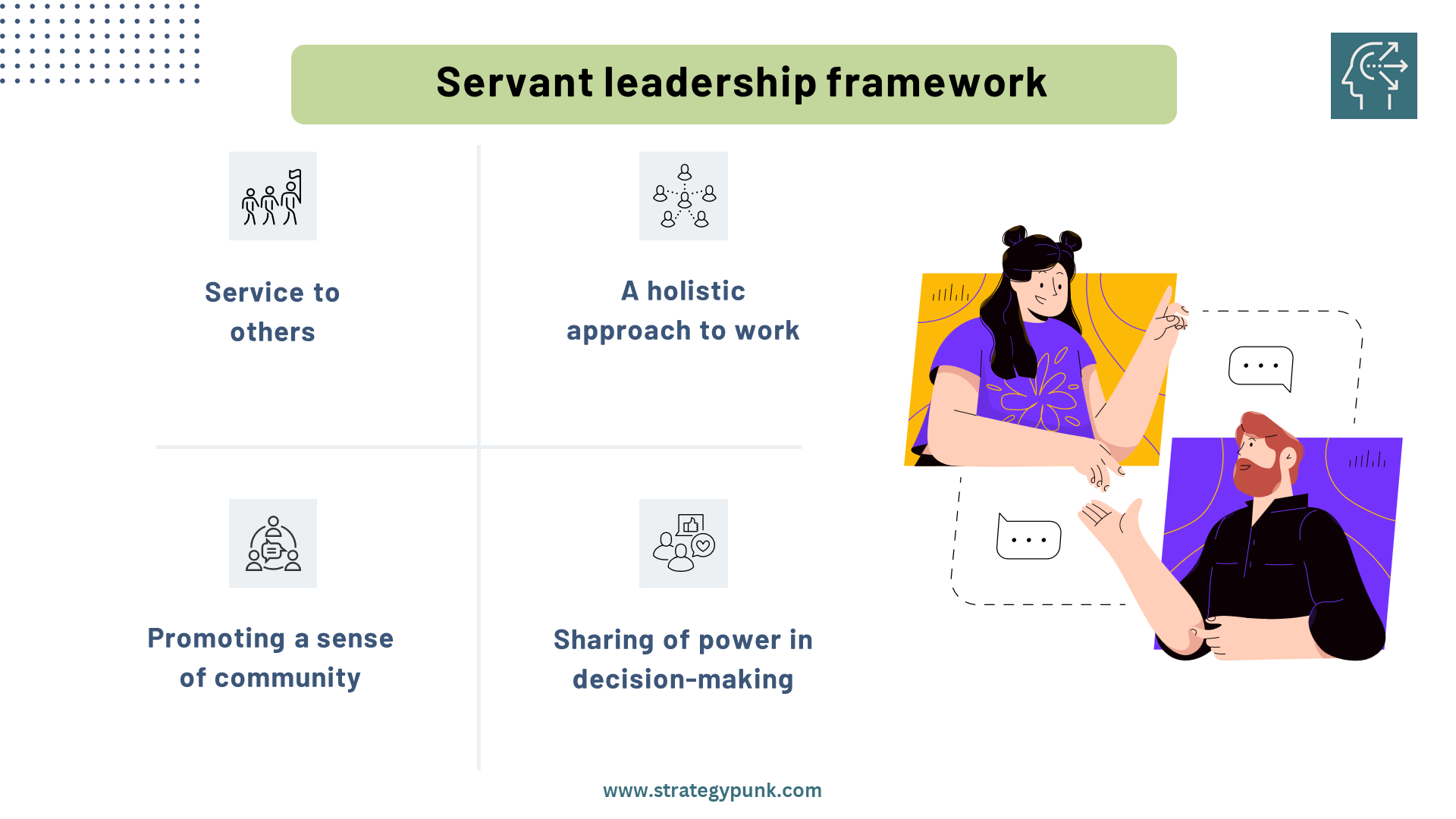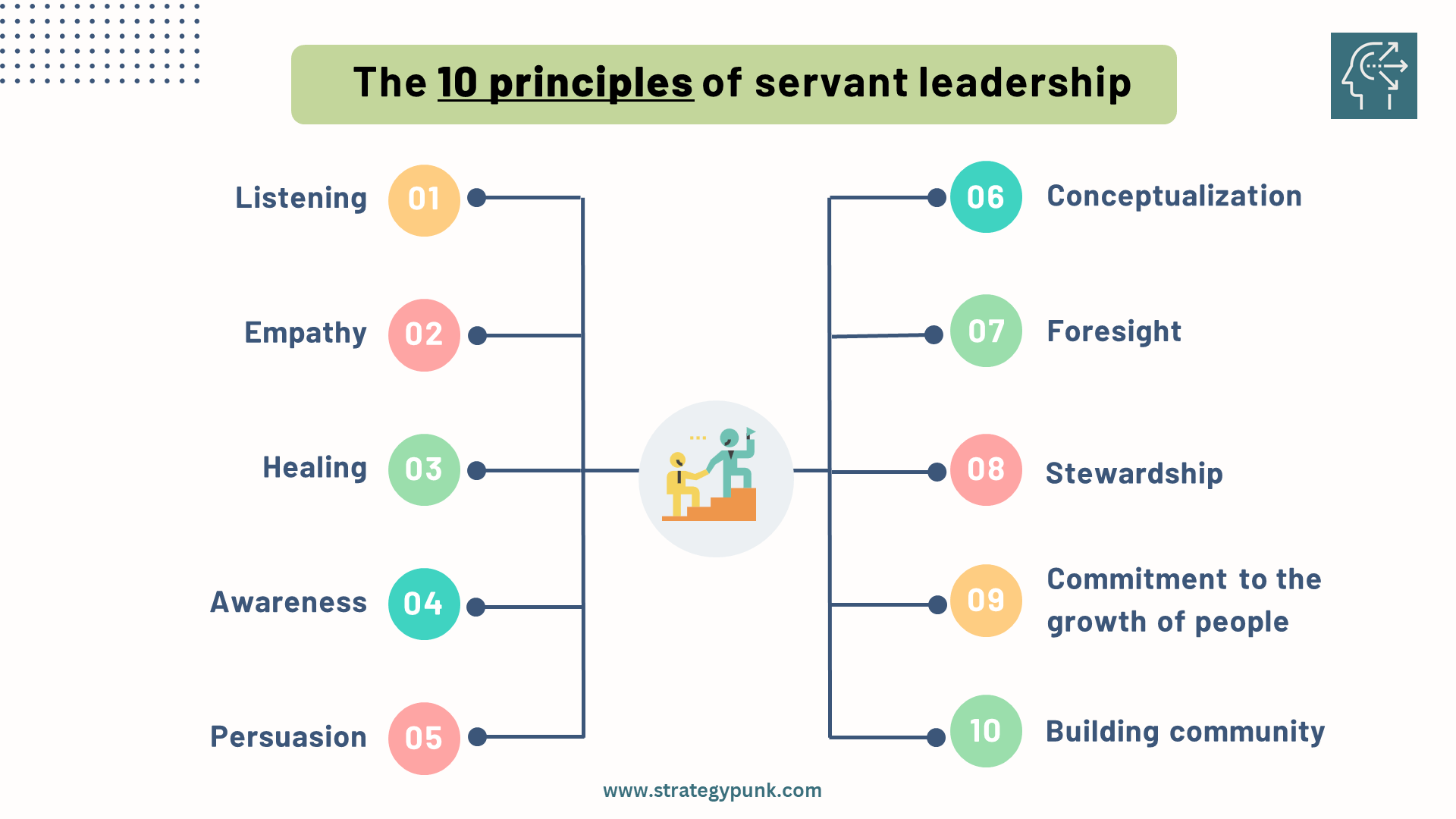What is Servant Leadership: Framework, 10 Principles, and Benefits (Plus FREE Template)
Servant Leadership Guide: Framework, 10 Principles, and Benefits (Plus FREE Google Slides and PowerPoint templates)

Servant leadership style is a leadership philosophy or approach that emphasizes serving others as a means to lead. Servant leaders are driven by a desire to help others, not an ambition to lead them. They focus more on lifting others than on lifting themselves.
By contrast, traditional leadership theories emphasize traits such as assertiveness, dominance, and self-confidence as necessary components of influential leaders. This stark contrast with servant leadership can enlighten those seeking to understand different leadership approaches.
Let’s take a look at the framework and top 10 principles of being a leader in the servant style.
What is servant leadership's origin?
In 1970, Robert K. Greenleaf (1904-1990) coined servant leadership in an article entitled The Servant as Leader. Greenleaf, a Terre Haute, Indiana native, spent his entire managerial career developing management research, development, and education at AT&T.
After working for AT&T for approximately 40 years, Greenleaf spent 25 years as an influential consultant for several leading institutions, including Ohio University, MIT, Ford Foundation, and tB. K. Mellon Foundation.
What is servant leadership?
Larry Spears, Executive Director of the Robert K. Greenleaf Center for Servant Leadership, explains the term servant leadership briefly as follows:
How does servant leadership differ from traditional leadership?
The servant leadership style emphasizes empathy and connection over control and domination. Influential servant leaders are driven by a desire to serve others, not an ambition to lead them.
Traditional leadership emphasizes assertiveness, dominance, and self-confidence as necessary components of influential leaders. A traditional leader is a person who is comfortable in a position of authority and possesses strong leadership qualities such as charisma, confidence, and self-assurance. Traditional leaders are used to leading people and delegating tasks to those under them. They enjoy being in control and keeping important information confidential from others.
The servant leadership framework
The servant leadership framework is a theory for creating an environment where everyone can thrive.

Whether you’re leading a small team, a large organization, or both, the servant leadership framework can empower you to establish a common purpose and clear goals while giving everyone the flexibility they need to succeed.
It also helps to create an organizational culture that respects individual contributions and is committed to supporting and empowering everyone.
Service to others
Serving others becomes a priority when a good leader assumes a servant's leadership position. Power and self-interest are not at the root of authentic leadership style.
A holistic approach to work
It calls on organizations to rethink the connections between people, organizations, and society.
According to the theory, individuals should be encouraged to be themselves professionally and personally. This would lead to a more integrated valuation of individuals that ultimately benefits the organization's long-term interests and performance.
Promoting a sense of community
Only communities where individual members are jointly liable for each other's actions can foster a sense of community. An organization may only succeed if it establishes this sense of community. Further, influential servant leaders' actions are the source of this sense of community.
Sharing of power in decision-making
The best demonstration of servant leadership is cultivating servant leadership qualities in others. By encouraging employees' talents, empowering work environments, and encouraging participatory behavior, a servant-leader improves employee motivation and, as a result, business performance.
There are many different ways to apply the servant leadership framework in organizations today. But it all starts with a straightforward concept: everyonehas value to bring regardless of their title or formal position. Suppose you can start seeing your team members as assets rather than liabilities. In that case, you’ll be on the right track to building a culture of servant leadership where everyone feels respected and integral to the organization's success.
What are the ten principles of servant leadership?
Servant leadership is a style that focuses on others' needs and desires. It’s about being a good listener, being willing to take the time to understand others, and working hard to make everyone around you feel heard and appreciated.
The following are Robert K. Greenleaf’s 10 servant leadership principles that every servant leader needs to keep in mind:

(Active) Listening
A great place to start with servant leadership is by listening actively.
Effective listening takes practice, but the rewards of being a good listener are immense. Perhaps one of the most important benefits is that it allows you to understand other people’s perspectives better. Being a good listener can also help you build better relationships, increase trust, and inspire confidence among your team members.
Being a good listener doesn’t mean that you have to wait for your turn to speak. Instead, it means you are genuinely interested in what the other person says. It means putting your thoughts and judgments aside and focusing on the person before you. When you listen to someone else, you give them your full attention. This speaks volumes and can have a tangible impact on your personal and professional relationships.
The servant leader also pays special attention to what goes unspoken in management.
Empathy
Empathy is the ability or capacity to understand or feel what another person is experiencing within their frame of reference. Influential leaders need to see situations from their team’s perspective and understand the feelings and emotions accompanying those situations.
Empathy can help you build better relationships with others and improve your ability to respond effectively to various situations. Influential servant leaders are dedicated to understanding and responding to their team’s unique needs and experiences, and empathy is at the heart of this approach.
Empathy is not the same as sympathy or pity. Sympathy is feeling sorry for someone, and compassion is feeling that someone is unfortunate or unfortunate. Empathy is about understanding and experiencing what someone else is going through from their perspective, not yours. Being genuinely empathetic takes practice, but it’s essential for servant leaders.
Healing
Another critical aspect of servant leadership is healing. This can take many forms, from healing the wounds of others who have experienced hardship to healing broken relationships within or between teams.
Healing is often seen as an inclusive and holistic process that involves people’s physical, emotional, and spiritual states. It can help individuals overcome their past and create a better future, and it can help them function more effectively and harmoniously.
Servant leaders recognize the importance of addressing their people's needs in these three areas of life. They realize that addressing these needs is often essential to inspiring confidence, trust, and loyalty among the people they lead.
Awareness
The servant-leader has broad awareness, particularly self-awareness. He can see circumstances from a more complete, comprehensive perspective.
Being aware of your actions and their impact on others is a crucial quality of servant leadership. Servant leaders are aware of their action's impact on their followers and are careful to respond in ways that respect and honor their team. In addition, they are also mindful of the effects of external forces on their organization, such as political or cultural factors.
Being aware is not just about being informed; it’s about being informed and then taking action. Awareness is about knowing your team members’ needs and how to respond to those needs in practical ways.
Self-reflection, listening to what others say, remaining open to learning, and connecting the dots are all ways to improve awareness.
Persuasion
The effective servant-leader builds group consensus through persuasion and does not take advantage of their power and status. This characteristic most clearly differentiates servant leadership from traditional, authoritarian styles.
Servant leaders should be persuasive but not manipulative. Being transparent means using your communication skills to persuade your team to move towards something they believe in. Persuasion is not coercion or manipulation.
Servant leaders use persuasion to inspire confidence, loyalty, and trust among their people. They know how to encourage people to move towards something that they believe in, and they do so honestly and ethically.
Conceptualization
A servant leader thinks beyond the day-to-day. He focuses on the long-term perspective.
Trust and confidence in your leadership skills and abilities are essential to inspiring confidence and loyalty among your followers. One of the best ways to build trust among your team members is to conceptualize your plans, strategies, and ideas in meaningful ways for your team.
Conceptualization is similar to persuasion in that it involves the ability to communicate your ideas effectively to others. The difference is that conceptualization is a broader skill of presenting any picture meaningfully. Conceptualization is essential in various contexts and situations, including strategy discussions, project planning, and goal setting. E
Foresight
Foresight is the ability to see the long-term implications of current actions and make informed decisions based on that vision. It is essential to servant leadership.
Foresight helps leaders avoid making short-term decisions derailing their long-term goals. It’s also important because it allows leaders to avoid making decisions based on knee-jerk reactions to current events.
Servant leaders can distance themselves from the immediacy of current situations and make decisions based on a long-term vision. Foresight helps leaders see past today’s problems and make decisions that benefit the team’s long-term growth. This characteristic is closely linked to the conceptualization term above.
Stewardship
Stewardship oversees and manages the most important things to their team members, such as their relationships and health. Servant leaders recognize the importance of caring for their followers physically and emotionally.
In addition, servant leaders are not only concerned for the individuals within their organization but also see the organization as a whole and its impact on society. It is linked to the obligation to help and serve others.
Commitment to the growth of people
Servant leaders recognize the importance of growing their people. They believe individuals have intrinsic values beyond their accomplishments as employees. As a result, they encourage and support employees' personal, professional, and emotional growth.
This commitment to people's growth can take many forms, from providing challenging and meaningful work to offering professional development and growth opportunities.
A leader committed to people's growth is dedicated to preparing their team members for the future. They recognize that their role is not just to get things done but to get the right things done and to do so in ways that allow their team members to thrive.
Building community
Finally, a crucial part of being a servant leader is building community among your team members. Communities are built on trust, loyalty, and the ability to work together effectively and efficiently.
A feeling of community among your team members can help encourage collaboration and support and create a culture of shared commitment and excellence. The community has an important social aspect, bringing together people from different backgrounds and helping them connect and learn from each other.
A servant leader seeks to foster a true community within his organization and among other businesses and organizations.
What are the benefits of servant leadership?
Servant leadership is a style in which the leader adopts the attributes of a servant. A servant leader acts with humility, empathy, and compassion. They are self-aware and know their strengths and limitations.
Servant leadership is a type of leadership that fosters an environment where everyone can contribute their unique strengths, capabilities, and perspectives to produce the best results possible.
- Servant leadership focuses on developing teams who are able to work together to achieve shared goals.
- Servant leaders create a culture where everyone feels valued and contributes meaningfully to the organization.
- Servant leaders focus on giving more than receiving.
- They create an environment where people feel comfortable taking risks and having honest conversations about issues that matter to them.
- They believe that everyone has something valuable to bring to the table, regardless of background or experience, and they show up for others in ways that make them feel heard and seen.
- Servant leaders are committed to building strong relationships with their team members so they can support each other in times of need.
How to become a servant leader
Servant leadership is a way of leading that emphasizes empathy and connection over control and domination. It’s about valuing the unique contributions of every team member and focusing on their strengths rather than their weaknesses.
The essential qualities of a servant leader are humility, respect, and compassion—qualities demonstrated by taking care of those you work with, listening to them, and prioritizing their needs over yours.
Another benefit of servant leadership is that it makes you more likely to make decisions based on what’s best for the people who work under you instead of doing whatever you think is best for yourself.
Taking this approach, you’re more likely to choose policies that support employee growth and development and end up with a more motivated and engaged team.
So what are you waiting for? Start being a servant leader right now by practicing these seven steps:
- Show respect for all people at all times
- Be open to feedback
- Be patient
- Be fairly minded
- Practice active listening
- Deeply care
- Take action
What are real-life examples of servant leadership?
A servant leader's goal is to help others achieve their goals. Examples of servant leaders are Abraham Lincoln, Mother Teresa, Martin Luther King Jr., and the Dalai Lama.
In today's business world, Howard Schultz, the Founder of Starbucks, and Susan Wojcicki, CEO of YouTube, are often called servant leaders.
Further readings about being (or becoming) a servant leader
- On Becoming a Servant Leader by Robert Greenleaf and Peter Drucker
- The Servant: A Simple Story About the True Essence of Leadership by James C. Hunter
- The Serving Leader: Five Powerful Actions to Transform Your Team, Business, and Community by Ken Jennings and John Stahl-Wert
- Great Twitter thread by Jamie Russo: 10 secrets of servant leaders
https://twitter.com/jamierusso/status/1565006919814692864
Servant Leadership Templates
Free and fully editable PowerPoint, PDF and Google Slides template
Download the Servant Leadership model in PDF format
Download the Servant Leadership model in Google Slides format (FREE and 100% editable)
Servant Leadership Google Slides format






